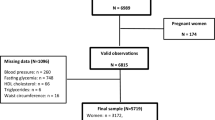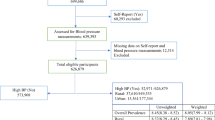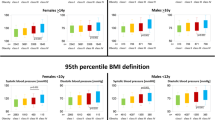Abstract
To investigate potential gender differences in the role of hypertension as a risk factor for metabolic syndrome (MetS) we used a random population sample of 50-year-old men (n=595) and women (n=667; all born in 1953) who were examined in 2003–2004. Systolic (SBP) and diastolic (DBP) blood pressure values were dichotomized at ⩾140 mm Hg and ⩾90 mm Hg, respectively. MetS was defined using NCEP (National Cholesterol Education Programme) and IDF (International Diabetes Federation) criteria. MetS was more prevalent in men than in women (NCEP 16% versus 10%, P=0.003; IDF 26% versus 16%, P=0.000) and systolic hypertension was more common in men than in women (high SBP 24% versus 18%, P=0.003; high DBP 29% versus 24%, P=0.074). Women with high SBP had about a seven-fold increased NCEP risk compared with normotensive women (odds ratio (OR) 6.91, confidence interval (CI) 2.90–16.42), whereas high SBP in men was associated with about a three-fold increased NCEP risk (OR 2.72, CI 1.69–4.38). A similar pattern was observed for the IDF criterion of MetS. All interaction terms (sex × hypertension) were significant at P<0.01. At middle age, despite that fewer women had hypertension or MetS than men, hypertension carries a relatively greater risk for MetS in women than in men.
This is a preview of subscription content, access via your institution
Access options
Subscribe to this journal
Receive 12 digital issues and online access to articles
$119.00 per year
only $9.92 per issue
Buy this article
- Purchase on Springer Link
- Instant access to full article PDF
Prices may be subject to local taxes which are calculated during checkout


Similar content being viewed by others
References
Lawes CM, Vander Hoorn S, Rodgers A . Global burden of blood-pressure-related disease, 2001. Lancet 2008; 371 (9623): 1513–1518.
Duvnjak L, Bulum T, Metelko Z . Hypertension and the metabolic syndrome. Diabetol Croatica 2008, 83–89.
Lewington S, Clarke R, Qizilbash N, Peto R, Collins R . Age-specific relevance of usual blood pressure to vascular mortality: a meta-analysis of individual data for one million adults in 61 prospective studies. Lancet 2002; 360 (9349): 1903–1913.
Grundy SM . Metabolic syndrome pandemic. Arterioscler Thromb Vasc Biol 2008; 28 (4): 629–636.
Cameron AJ, Shaw JE, Zimmet PZ . The metabolic syndrome: prevalence in worldwide populations. Endocrinol Metab Clin North Am 2006; 33: 351–375.
Gale EA . The myth of the metabolic syndrome. Diabetologia 2005; 48 (9): 1679–1683.
Kahn R, Buse J, Ferrannini E, Stern M . The metabolic syndrome: time for a critical appraisal: joint statement from the American Diabetes Association and the European Association for the Study of Diabetes. Diabetes Care 2005; 28 (9): 2289–2304.
Reaven GM . The metabolic syndrome: requiescat in pace. Clin Chem 2005; 51 (6): 931–938.
Robins JL, McCain NL, Elswick Jr RK . Exploring the Complexity of Cardiometabolic Risk in Women. Biol Res Nurs 2011 (e-pub ahead of print 15 March 2011; doi:10.1177/1099800411398652).
2003 European Society of Hypertension-European Society of Cardiology guidelines for the management of arterial hypertension. J Hypertens 2003; 21 (6): 1011–1153.
Boggia J, Thijs L, Hansen TW, Li Y, Kikuya M, Bjorklund-Bodegard K et al. Ambulatory Blood Pressure Monitoring in 9357 Subjects From 11 Populations Highlights Missed Opportunities for Cardiovascular Prevention in Women. Hypertension 2011; 57 (3): 397–405.
Kannel WB . Incidence and epidemiology of heart failure. Heart Fail Rev 2000; 5 (2): 167–173.
Johansson S, Wilhelmsen L, Welin C, Eriksson H, Welin L, Rosengren A . Obesity, smoking and secular trends in cardiovascular risk factors in middle-aged women: data from population studies in Goteborg from 1980–2003. J Intern Med 2010; 268 (6): 594–603.
Rosengren A, Eriksson H, Hansson PO, Svardsudd K, Wilhelmsen L, Johansson S et al. Obesity and trends in cardiovascular risk factors over 40 years in Swedish men aged 50. J Intern Med 2009; 266 (3): 268–276.
Welin L, Adlerberth A, Caidahl K, Eriksson H, Hansson PO, Johansson S et al. Prevalence of cardiovascular risk factors and the metabolic syndrome in middle-aged men and women in Gothenburg, Sweden. BMC Public Health 2008; 8: 403.
Wilhelmsen L, Welin L, Svardsudd K, Wedel H, Eriksson H, Hansson PO et al. Secular changes in cardiovascular risk factors and attack rate of myocardial infarction among men aged 50 in Gothenburg, Sweden. Accurate prediction using risk models. J Intern Med 2008; 263 (6): 636–643.
Expert Panel on Detection, Evaluation, and Treatment of High Blood Cholesterol in Adults.. Executive Summary of The Third Report of The National Cholesterol Education Program (NCEP) Expert Panel on Detection, Evaluation, And Treatment of High Blood Cholesterol In Adults (Adult Treatment Panel III). JAMA 2001; 285 (19): 2486–2497.
Alberti KG, Zimmet P, Shaw J . IDF Epidemiology Task Force Consensus Group: the metabolic syndrome—a new worldwide definition. Lancet 2005; 366 (9491): 1059–1062.
Ford ES, Li C, Sattar N . Metabolic syndrome and incident diabetes: current state of the evidence. Diabetes Care 2008; 31 (9): 1898–1904.
Tan YY, Gast GC, van der Schouw YT . Gender differences in risk factors for coronary heart disease. Maturitas 2010; 65 (2): 149–160.
Ninios I, Ninios V, Lazaridou F, Dimitriadis K, Kerasidou O, Louridas G . Gender-specific differences in hypertension prevalence, treatment, control, and associated conditions among the elderly: data from a Greek population. Clin Exp Hypertens 2008; 30 (5): 327–337.
Redon J, Cifkova R, Laurent S, Nilsson P, Narkiewicz K, Erdine S et al. The metabolic syndrome in hypertension: European society of hypertension position statement. J Hypertens 2008; 26 (10): 1891–1900.
Vega GL, Adams-Huet B, Peshock R, Willett D, Shah B, Grundy SM . Influence of body fat content and distribution on variation in metabolic risk. J Clin Endocrinol Metab 2006; 91 (11): 4459–4466.
Grassi G, Seravalle G, Stella M, Mancia G . Pathophysiological aspects of hypertensive disease in women. J Hypertens 2002; 20 (Suppl 2): 6–10.
Ren J, Kelley RO . Cardiac health in women with metabolic syndrome: clinical aspects and pathophysiology. Obesity (Silver Spring) 2009; 17 (6): 1114–1123.
Regitz-Zagrosek V, Lehmkuhl E, Weickert MO . Gender differences in the metabolic syndrome and their role for cardiovascular disease. Clin Res Cardiol 2006; 95 (3): 136–147.
Stadberg E, Mattsson LA, Milsom I . The prevalence and severity of climacteric symptoms and the use of different treatment regimens in a Swedish population. Acta Obstet Gynecol Scand 1997; 76 (5): 442–448.
Acknowledgements
This study was supported by the Swedish Research Council, the Swedish Heart and Lung Foundation, and the Swedish Labour Market Insurance Company. We acknowledge the statistical advice of Georgios Lappas, Statistician.
Author information
Authors and Affiliations
Corresponding author
Ethics declarations
Competing interests
The authors declare no conflict of interest.
Rights and permissions
About this article
Cite this article
Novak, M., Björck, L., Welin, L. et al. Gender differences in the prevalence of metabolic syndrome in 50-year-old Swedish men and women with hypertension born in 1953. J Hum Hypertens 27, 56–61 (2013). https://doi.org/10.1038/jhh.2011.106
Received:
Revised:
Accepted:
Published:
Issue Date:
DOI: https://doi.org/10.1038/jhh.2011.106
Keywords
This article is cited by
-
Body impedance analyzer and anthropometric indicators; predictors of metabolic syndrome
Journal of Diabetes & Metabolic Disorders (2021)
-
Prevalence of metabolic syndrome and its determinants among Iranian adults: evidence of IraPEN survey on a bi-ethnic population
Scientific Reports (2019)
-
Decreased global DNA methylation in the white blood cells of high fat diet fed vervet monkeys (Chlorocebus aethiops)
Journal of Physiology and Biochemistry (2014)



